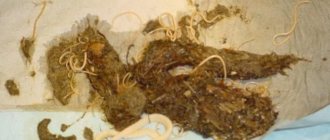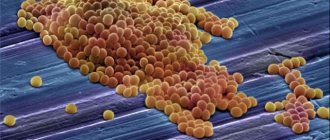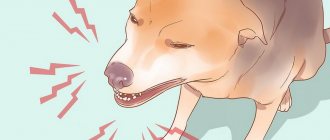Any pet, regardless of whether it is on a street walk or leads an exclusively domestic lifestyle, in most cases is already infected with helminths. These parasitic worms are present almost everywhere: in puddles, ditches, on grass, in the ground, in fish and meat products.
Many dog owners, without knowing it, are carriers of parasites. Upon returning home from the street, most people do not try to wash their street shoes, but, as a rule, leave them in the hallway. Dogs love to chew, sniff or lick their owner’s shoes, and along with the dirt, helminth eggs also enter the pet’s body.
Worms in dogs are a very common problem that needs to be addressed as quickly as possible. By parasitizing the animal's body, helminths not only suck out all the beneficial substances from the dog's body, but also cause severe intoxication, often ending in the death of the dog.
Deworming is the most effective way to combat parasites, protecting not only the animal, but also its owners from worms. Not a single veterinarian will allow an animal to participate in exhibitions, mating, or undertake to vaccinate a four-legged friend if the dog is not treated for worms before vaccination.
Types of worms in dogs
Experts know many varieties of worms that parasitize inside the body of pets.
Some worms in dogs live and multiply in the digestive tract, causing diseases of the internal organs and causing severe exhaustion or chronic diarrhea in the animal. Some types of helminths prefer to live in the organs of the cardiovascular system and lungs, leading to disruption of the heart, the development of pneumonia, and a painful cough. Most worms that infect the body of pets pose a real danger to human life, so it is important to know what worms look like in dogs.
There are 3 groups of parasitic worms:
- Nematodes or roundworms.
- Cestodes or tape parasites.
- Flukes , known as flatworms.
More than 80 varieties of roundworms are found in nature, but not all parasites can live in the body of a pet.
Nematodes have a round (spherical) body shape, which is why they got their name.
The most common helminthic infestations caused by roundworms are:
- Dirofilariasis . The causative agent of the disease is a white worm, the females of which reach a length of 15 cm, and the males - no more than 5 cm. Mosquitoes serve as intermediate hosts of the helminth. The larvae (microfilariae) of the parasite enter the dog’s body through the bite of a blood-sucking insect, then, through the bloodstream, rush to the main muscle - the heart. Living and actively reproducing in the organ, worms lead to disruption of its functioning. Gradually, all the cavities of the main muscle can be filled with helminths, which is why the animal always dies. Dirofilariasis is a very severe infestation, since in the early stages of the development of the disease all the signs are similar to heart failure, and an incorrect diagnosis can cost the dog his life.
- Toxocariasis . The disease is caused by 20 cm helminths with a light yellow body color. After penetrating the dog’s body, the worm larvae enter the bloodstream and spread to the vital organs of the animal (first to the liver, then to the heart and lungs).
- Ascariasis (toxascariasis). Parasitic worms have a body length of about 8 cm and are colored light yellow. Roundworms prefer to live in the intestines, gall bladder, liver and esophagus of dogs. Infection with ascariasis occurs mainly in places where dogs gather in large numbers (walking areas). Failure to treat the infestation soon leads to the death of the animal.
Cestodes are considered the largest parasitic worms. People call tapeworms tapeworms, since in appearance their body looks like a chain consisting of links.
The length of some adult worms reaches more than 10 meters. The parasite is equipped with a scolex (oral apparatus) and hooks, thanks to which it literally pierces the organs of its victim. The body of the tapeworm consists of many segments (segments). In each of the segments, the eggs of the parasite mature.
Together with feces, the segments leave the dog’s body, enter the external environment, and dry out under the influence of oxygen, leaving behind a large number of eggs.
Dogs become infected only through intermediate hosts (river fish, amphibians, blood-sucking parasites, rodents). When eating an infected animal, insect or fish, the dog swallows the parasite larva along with the food.
Once in the gastrointestinal tract, the larva is securely attached to the intestinal walls, actively feeds, grows, and after a short period of time reaches maturity.
Tapeworms in dogs are dangerous because when they accumulate massively in the intestines, they form peculiar balls, leading to complete blockage and then rupture of the organ.
Cestodes cause the following diseases:
- Diphyllobothriasis . The disease is caused by long tapeworms, their body length can be more than 10 m. Dogs become infected by eating raw fish, in which a helminth larva develops in the body.
- Dipylidia (cucumber tapeworm). The causative agent of the disease is a tape parasite with a body length of 1.5 m. Every day the worm rejects its segments containing eggs. The intermediate host of the helminth is a blood-sucking insect (in most cases fleas). A dog gets worms when it accidentally ingests a flea.
- Echinococcosis . The culprit of the disease is considered to be a tiny tapeworm, with a body length of no more than 0.5 cm. The mouthparts of the helminth are equipped with many hooks that cause severe injuries to the intestinal walls. Echinococcosis affects not only dogs, but also other animals, including farm animals.
Trematodes differ from other helminths in their small flat body, with the help of which they attach themselves to vital organs (lungs, intestines, pancreas, liver). Flukes feed on lymph, blood and mucus.
Dogs become infected by eating raw fish, frogs, and also through contact with the feces of sick animals. Trematodes cause the following diseases:
- Paragonimiasis . Flukes have an egg-shaped body, the length of which is no more than 1.3 cm. The intermediate hosts of the helminth are crustacean mollusks.
- Alariasis . The length of the parasite is no more than 4 mm, intermediate hosts are amphibians.
- Opisthorchiasis . The parasite is small in size (about 4 cm). Worm larvae can be found in raw fish or float in fresh water.
Side effect
A number of small breed pet owners complain that anthelmintic drugs are toxic. And as side effects, pets experience vomiting, foaming at the mouth, and nervousness. They may refuse to eat, and in some cases there is even death. But the latter is nothing more than rumors.
The body's natural reaction to taking this type of medication is to feel unwell. It goes away without a trace after just a day. Lethal outcomes occur only in cases where the treatment is carried out too diligently: for example, the owner gives the pet the entire range of drugs to certainly kill the parasites. The young animal also dies in cases where the body has already been too depleted of helminths. When the drugs killed them, the dead worms released too many toxins.
Sometimes allergic reactions occur, but they are provoked by the initial individual characteristics of a particular individual. In cases where an animal is allergic to the drug, anthelmintics are combined with antihistamines.
Ways of infection of dogs with worms
All dogs are susceptible to helminthiasis, regardless of age and breed. Sometimes it is difficult to understand that a dog has worms. In some cases, the infestation may remain asymptomatic for a long time. Small puppies and teenage dogs are more susceptible to helminthic diseases than their adult counterparts. The presence of worms in the body can be caused by different routes of parasite penetration:
- Hematogenous. Some parasites are transmitted to dogs through insect bites. Helminth larvae penetrate the animal’s bloodstream and then spread throughout the body.
- Oral. The eggs of parasitic worms enter the dog’s body through direct contact of the pet with sources of infection (feces of sick animals, food, soil, standing water).
- Intrauterine . A pregnant bitch is capable of transmitting helminths to her offspring. The most common disease transmitted from mother to fetus is toxocariasis.
Find out in what cases a person can become infected with worms from a dog>>>
Folk remedies against helminths
You should not transfer human experience of treatment for worms to your dog. Humans and dogs have different physiology. Keep in mind that garlic, which is used in folk medicine as an anthelmintic, is dangerous for dogs, it destroys red blood cells and causes anemia, and a dog infected with worms is therefore weakened.
Infusions of medicinal herbs cause allergies and have contraindications. Before asking the Internet how to worm a dog, ask yourself two questions: how to calculate the dosage and how to pour decoctions into the dog.
Do not torture your pet and yourself with experiments. Tablets or suspension are given once, maximum twice. Feeding them to a dog is much easier than pouring the broth from a syringe into the mouth.
Symptoms of worms in dogs
Any owner of a four-legged friend should know the signs of a helminthic infestation that has developed in a pet. Symptoms of worms in dogs are as follows:
- Dramatic weight loss. Parasitic worms suck out all the beneficial substances from the dog, as a result of which the animal’s body becomes exhausted.
- Frequent rumbling in the stomach, an increase in the volume of the abdominal cavity. Worms in dogs, such as roundworms, cause similar symptoms.
- Frequent vomiting. Occurs mainly when dogs are infected with tapeworms.
- Prolonged diarrhea. Indicates infection with whipworms or nematodes.
- Blood and mucus in feces. Happens when dogs are affected by hookworm.
- Skin rash, dullness and hair loss. It is considered a characteristic sign of roundworms.
- The presence in the animal's feces of white moving segments, similar to rice or cucumber grains. In this case, determining that a dog has worms (cestodes) is not difficult.
- Painful sensations and itching in the perineum. The animal constantly tries to ride on its butt and lick the anus. This behavior indicates characteristic signs of worms in a dog.
- Paleness of the mucous membranes of the eyes and mouth. The dog's loss of nutrients leads to the development of anemia.
In dogs of small breeds, helminthic infestations are more severe than in large dogs. Most decorative pets do not tolerate anthelmintic drugs well, so pets should be treated only under the strict supervision of a veterinarian.
Parasites living in the heart are quite difficult to identify. You can know that your dog has worms if you experience symptoms such as:
- increased breathing, attacks of shortness of breath;
- abdominal enlargement;
- painful cough;
- severe weakness of the body;
- sudden hair loss.
Heartworm is dangerous because all the symptoms of its presence appear only when the disease has become widespread and it is no longer possible to save the dog.
"Milbemax"
Owners often prescribe this remedy for their pets on their own. Most often, such prevention is carried out before giving the dog an annual vaccination. Indeed, due to the weakened immune forces of the body, the pet may not react so well to the introduction of the vaccine.
Give the medicine in the morning on an empty stomach. You should not avoid examining feces, because parasites that are still alive or dead may be found there. And this will be evidence that the invasion is quite strong. It is important to repeat taking the medication. In this case, the repetition is carried out after different periods, taking into account the individual characteristics of the pets and the nuances of the course of their illness.
The main active component of the product is a substance that affects both adult worms and larvae. Ultimately, the drug becomes essentially universal. Purchase it at a veterinary pharmacy.
Treatment of helminthic infestations in dogs
Helminths in dogs are very dangerous and require immediate treatment for your four-legged pet. If you suspect a worm infection, you should contact a veterinarian.
Only a doctor can accurately determine the type of parasite and prescribe effective treatment that can remove worms from a dog. Self-administration of antihelminthic drugs can lead to severe poisoning and death of the pet.
Veterinarians advise using the following medications for helminths:
- Kanikquantel is an effective anthelmintic drug that provides gentle treatment. Produced by German manufacturers. It differs from many drugs in the absence of side effects and reasonable price. Has a wide spectrum of action.
- Prazitel - has a destructive effect on any helminths. Approved for therapy of puppies.
- Drontal plus - has a powerful destructive effect on tape parasites, but is not effective in combating helminth larvae.
- Milbemax – fights round and tape parasites.
All products that destroy worms are produced in several versions: tablets, suspensions, pastes, drops. The anti-worm drug Bars for dogs, produced in the form of drops on the withers, is in particular demand. The medicine is easy to apply and protects the animal from helminths for a long time.
Find out more about deworming products for dogs>>>
Treating a dog at home using folk remedies is unsafe. Most medicinal plants used to get rid of worms cannot completely rid the animal of parasites. In addition, self-medication of pets threatens to result in serious poisoning, so treatment of helminthic infestations should be carried out only by a professional.
Before using any medicine aimed at combating worms, you must first remove fleas from the animal. If you neglect this rule, the effectiveness of therapy decreases sharply. In order to cure a dog of ectoparasites, various shampoos, drops, sprays and collars are used.
Tablets used to kill worms are given strictly according to the weight of the animal. Preliminary fasting is usually not required. The drug is finely ground, mixed with a treat (food, minced meat) and given to your four-legged friend. After 10-14 days, the treatment against helminths is repeated (to destroy the larvae hatched from the eggs). The deworming procedure is carried out once every 3 months.
Prevention of infection. Veterinarian advice
The peculiarities of the biology of worms and the imperfect diagnosis of these diseases force veterinarians to recommend the following scheme of preventive deworming.
It includes:
- quarterly treatments of adult animals;
- giving anthelmintics 10 days before mating, a week before and a week after birth;
- deworming of dog puppies, starting from 2-3 weeks of age, every 3 weeks until reaching 3 months of age;
A heavily infected puppy may become ill from the drugs, because dead worms release toxins that cause poisoning. The puppy may experience diarrhea, vomiting, and loss of appetite, so it is useful to give the puppy a spoonful of Vaseline oil, which removes toxins from the body.
In addition, it is important to carry out treatment 10 - 14 days before vaccination. This is necessary in order to eliminate the inhibitory effect of helminthiasis on the immune system and to obtain the maximum effect from vaccination.
It is also necessary to prevent flea infestation, as they are often carriers of helminthic diseases.
If there is a need to “free” a cat or dog from helminths or there is a suspicion of infection, therapeutic deworming is carried out. It includes 2-3 times the administration of anthelmintic drugs with an interval of 10 days.
deworming for therapeutic purposes after examination and consultation with a veterinarian, especially if the animal’s condition requires veterinary care. The specialist will select the necessary treatment regimen and give recommendations on the care and maintenance of your animals.
Video
Fleas
What happens to the dog:
- Restlessness, especially during sleep. The animal does not find a place for itself and constantly wakes up.
- Aggression occurs against a background of constant nervous excitement and lack of sleep.
- Increased shedding and entire patches of baldness.
- Bite marks, wounds, scratches.
- Allergic reactions.
- Depressed state, symptoms of intoxication of the body.
- If you inspect the fur, you can find feces of fleas and their larvae, as well as the insects themselves.
Ticks
Ticks are the most numerous group of insects. They come in different sizes, and some are visible only under a microscope, such as scabies mites, which cause sarcoptic mange. There are ixodid ticks, which are a source of infection for humans with encephalitis, and for dogs with other dangerous diseases, such as piroplasmosis (babesiosis).
- Insects are visible when examining a dog; they often infect thin-haired parts of the body: ears, groin, armpits, etc. You just need to part the hair.
- Anxiety. After a few hours, the animal will feel itching in the bite area.
- There is a wound with dried blood, and the skin around it is red and swollen.
- Allergic reactions.
- When infected with vector-borne diseases - signs of anemia (anemia), depression, exhaustion, refusal to eat, fever, dark urine.
Signs of infestation by microscopic mites:
- Ear mites: the inside of the ear becomes red, inflamed, and black crusts appear (the waste products of the mite). The dog is worried, scratching its ears, shaking its head. If left untreated, deafness, otitis media or meningitis develops.
- Sarcoptic mange, or mange, in dogs: the head, neck and forelimbs are often affected. On these parts of the body, the skin becomes rough and dark, and severe itching appears in these places. The animal is worried and scratches the affected areas. Papules and pustules appear. Exhaustion and intoxication develop.
- Demodicosis: baldness of the affected areas of the skin, redness, itching, swelling, ruffled fur, in some places it even sticks together at the roots. The dog becomes restless, aggressive, and itching appears over time. Over time, the dog loses weight, the condition worsens, and signs of intoxication are observed. If the disease is not treated, then blood poisoning and internal organ disease are possible.
Preventive actions
Even pets living at home are susceptible to helminthiasis or infection with external parasites.
Regular preventive measures will help protect your beloved pet from dangerous diseases caused by parasites, as well as protect family members and especially children who come into contact with the dog.
Necessary:
- Feed your dog only thermally processed food.
- Do not allow your pet to come into contact with street animals. Free range can only be allowed within a fenced area.
- Carry out deworming three times a year, choosing drugs with the consent of the veterinarian, only after examining the animal.
- Rid your pet of external parasites that are carriers of helminthiasis.
- Periodically treat the place where the dog lives, as well as its objects: toys, clothes, combs.
Compliance with hygiene and nutrition standards, regular consultations with a specialist and timely deworming will help prevent helminthiasis and the development of secondary pathologies caused by it.
Zoonotic parasites
Pet owners are interested in which dog parasites are transmitted to humans. A large number of helminth eggs accumulate at the anus.
By licking itself, the animal transfers them to other areas of the body. Close contact with a dog can lead to infection. Most often, tapeworms and roundworms migrate from dogs.
The tick is also dangerous for humans, as it easily spreads to the epidermis, clothing and bedding of a person upon contact. When petting your dog, you can become infected with scabies, ringworm and dermatophytosis (fungal infections).
Flukes
Dog and cat flukes usually parasitize the bile ducts and penetrate the pancreas and liver. They have two suckers: one is located near the mouth opening, and the other is on the belly. Length no more than a few millimeters.
Animals become infected by eating raw fish or drinking contaminated water. Opisthorchis felineus (opisthorchiasis) is also most often found in dogs. For a long time, infection is asymptomatic. With severe invasion, inflammatory processes, difficulty in the outflow of bile, and even the development of cirrhosis of the liver are possible. In this case, the animal's mucous membranes turn yellow, weight loss and depression are observed.
Diagnosis of parasites
Only a specialist can determine the type, stage and degree of infection. The doctor prescribes a stool test and, if necessary, a blood test, which helps determine the pet’s condition and the level of functional changes in the body.
If helminthiasis is suspected, affecting the heart, bladder, lungs and liver, an ultrasound or radiography is prescribed.











